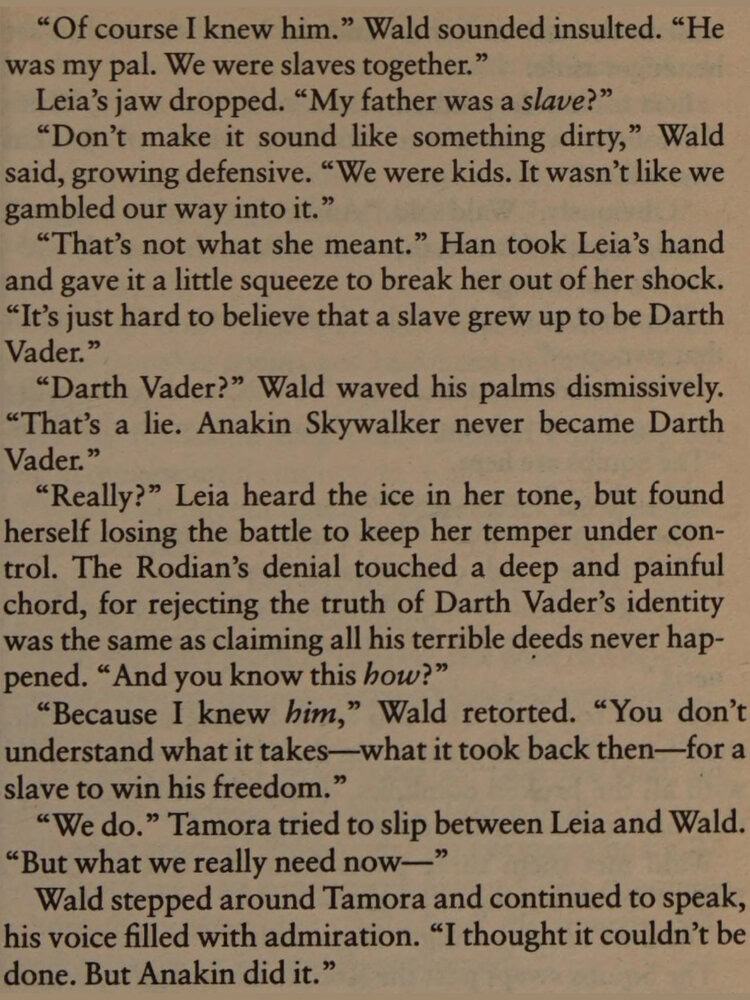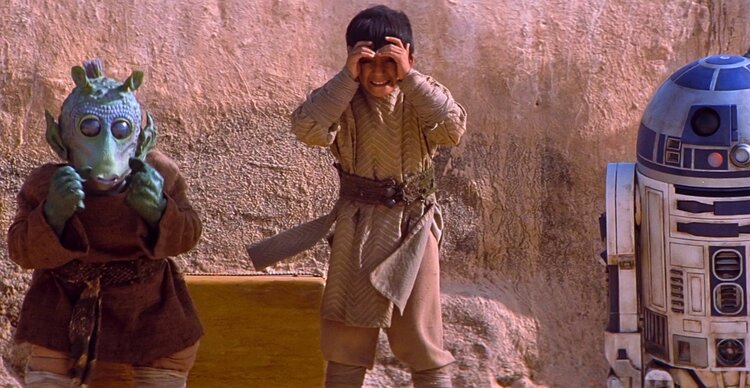There’s a moment in Tatooine Ghost where Leia suddenly falls into her father’s past on Tatooine, and everything she thought she understood about him starts to shift. The people who grew up with him don’t talk about a Sith Lord at all. They talk about a kid who worked in a junkyard and dreamed of flying.
This is where the story gets into how Anakin’s childhood friends reacted when they learned he became Darth Vader, and how those reactions shaped Leia’s understanding of her father.
Returning To Mos Espa And Hearing “Ani” Again
When Leia, Han, Chewbacca, and C-3PO travel to Tatooine to recover the Killik Twilight painting, Leia expects a tough mission and some old Rebel business. She doesn’t expect to hear Anakin Skywalker announced at an auction, attached to a simple holocube of the Boonta Eve Classic.
Hearing Anakin’s name in public throws her off balance. Most people in the galaxy only remember Darth Vader. Almost no one mentions the child he used to be, or where he came from. Leia follows that thread and ends up meeting the people who knew him in Mos Espa, many of whom still talk about “Ani” as if he never left.
Their memories clash with hers immediately. Many slaves on Tatooine see Anakin as a symbol of hope. He won a podrace no Human had ever won, and he walked off the planet with the Jedi. For them, Anakin represented the idea that freedom was possible, even for someone born into slavery.
Leia, who lived through Vader’s cruelty, has trouble hearing any praise connected to him, and that tension sits at the center of everything that follows.
Wald’s Reaction: Loyalty, Denial, And A Guarded Memory
Leia’s first major conversation is with Wald, a Rodian who worked with Anakin in Watto’s junkyard and stayed friends with him during their childhood. Once she brings up Anakin, Wald reacts with pride right away:
“Of course I knew him.” Wald sounded insulted. “He was my pal. We were slaves together.”
When Leia learns her father had been a slave, she freezes. That detail hits her harder than she expected. Wald notices the shift, and the more Leia presses, the more protective he becomes. When Han brings up Vader, Wald shuts the idea down:
“Darth Vader?” Wald waved his palms dismissively. “That’s a lie. Anakin Skywalker never became Darth Vader.”
For Wald, Anakin’s victory over slavery is the core of his memory, and no one is allowed to touch it. He goes on:
“Because I knew him,” Wald retorted. “You don’t understand what it takes—what it took back then—for a slave to win his freedom.”

Wald holds onto the Anakin he remembers, and he refuses to connect that boy to the man who later helped run the Empire. He focuses on the part of Anakin’s life that gave hope to kids like them on Tatooine. That is the version of his friend that he keeps alive.
Leia struggles with this moment. Wald’s refusal stings because it feels like he’s refusing to acknowledge Vader’s crimes at all. In her mind, rejecting that truth also rejects everything she suffered under the Empire.
Both sides leave the conversation frustrated. Wald keeps his belief. Leia keeps her anger.
Anakin As A Local Hero
As Leia meets more people, she notices a pattern. Many on Tatooine know the story of the slave boy who won the Boonta Eve Classic. They talk about him as someone who gave them encouragement. His win was more than a race to them. It represented a way out.
This reaction affects Leia deeply. Hearing strangers call Anakin a hero challenges the image she had carried all her life. Her father’s past in Mos Espa feels nothing like the figure she grew up fearing.
Still, the positive memories around her don’t help her understand how that boy became Darth Vader. She meets many people who admire him, but none who can bridge those two identities.
That changes when she finds Kitster.
Kitster’s Understanding: Connecting The Boy, The Pain, And Vader
Kitster Chanchani Banai, Anakin’s closest childhood friend, gives Leia a different kind of answer. By the time of Tatooine Ghost, Kitster has lived a full life on Tatooine. He won his freedom, worked hard for years, built a family, and dealt with more trouble than he ever wanted. He doesn’t live in the same hopeful memories as Wald. He remembers the joy of their childhood, but he also knows pieces of Anakin’s life that others never learned.
Kitster believed Anakin died during the Jedi Purge at first. Later he found out what truly happened. He also learned about Anakin’s return to Tatooine before the Clone Wars, the moment that ended with the massacre of the Tusken Raiders. And he knows why it happened.
He tells Leia about Shmi’s funeral:
“Of course. Beru told me that when they buried Shmi, Anakin spoke to her grave, saying he had not been strong enough to save her, but promising he would not fail again.”
Leia reacts with confusion:
“Fail again?” Leia asked. “But his mother was already dead. How was he going to undo that?”
Kitster explains more:
“She told me that he had said twice that he was not strong enough—once that he was not strong enough to save his mother, and the second time just that he was not strong enough. I thought at the time that he had just repeated himself, but now I’m not so sure.”
He connects those words to Anakin’s actions at the Tusken camp:
“After being at the oasis, I think maybe Anakin realized what a terrible mistake he had made. I think he knew how he had failed as a Jedi.”

For Kitster, this moment marks the turning point. He accepts that Anakin became Darth Vader, but he also believes the boy he knew still existed under everything that came later:
“The boy I knew would have been sorry for what he had done, and even ten years away would not have changed that. He was still his mother’s son.”

Kitster does something no one else offers Leia. He doesn’t deny Vader’s existence, and he doesn’t try to soften what Anakin became. He explains how the person he grew up with could fall apart after losing Shmi and carry that pain for the rest of his life.
His view finally gives Leia a way to understand both sides of her father.
Last Words
Throughout Tatooine Ghost, Leia moves through several stages as she meets Anakin’s old friends:
- She hears his name at the auction and learns he was a slave.
- She sees how Tatooine remembers him: the kid who showed that freedom was possible.
- She clashes with Wald, who insists Anakin could never become Vader.
- She listens to Kitster, who explains the link from Shmi’s death to Anakin’s collapse and then to Vader.
Kitster’s words, along with the holograms of young Anakin and Shmi, help her release the anger she carried for so long. She doesn’t erase Vader’s actions or forget what he did. She finally understands how the frightened boy in Mos Espa and the armored enforcer of the Empire could be the same person.
The reactions of Anakin’s childhood friends show different sides of the same story:
- Wald holds onto the boy who escaped slavery and refuses any connection to Vader.
- The people of Mos Espa remember a hero who showed them a path toward freedom.
- Kitster accepts everything Anakin became and still believes the boy he grew up with carried regret beneath the armor.
Together, these voices give Leia something she never had before: a complete picture of her father’s origins. Not the Jedi Knight from official history, not the Sith Lord from Imperial fear, but the kid who lived in the same dust, played with the same friends, and loved his mother more than anything.
Through them, she finally sees the whole story.

